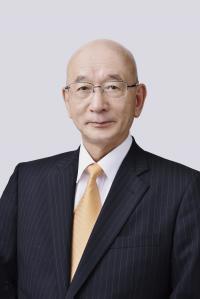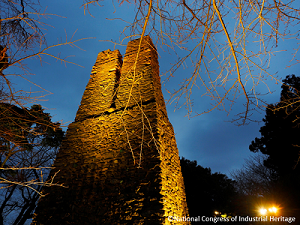PEOPLE
Mayor of Hagi City

I Would Like to Invite Every Citizen in Hagi to be a Guide to the Five Component Parts
Kato The Matsushita Village School, located in the Shouin Shrine, is so well known throughout Japan that it needs no explanation. Whenever NHK's historical drama series about the end of the Tokugawa Shogunate is aired, many tourists flock to the site, do they not?
Tanaka Since its registration as a World Heritage Site, it has become an increasingly popular destination. As it is well known, the Matsushita Village School was a private school run by Yoshida Shoin, who advocated the Theory of Engineering Education, from 1857 to the following year. Both the house where Shoin was imprisoned and the building for cram school together form one of the component parts of the Matsushita Village School. The school itself is a small space with only two rooms, but the spirit of Hagi that was nurtured there is dynamic. The people of Hagi are not only proud of the historical site of the school, but also of a man Yoshida Shoin himself. Once, in the prefectural assembly, there was a person who called Yoshida Shoin without honorifics and was scolded by the chairman of the assembly, who was from the area, "Please address him as Yoshida Shoin-sensei." (Laugh)
Kato The popular Hagi Castle Town is an archaeological site that shows the politics, administration, and economy in the community at the end of the Edo period when Japan was trying to industrialize. The three districts of “Hagi Castle Town”—the castle ruins, the old senior samurai estates, and the old townspeople's estates—are highly regarded by experts. I am most impressed by the fact that the town has remained in a beautiful condition after all these years.

Tanaka Hagi has never had an air raid, so it is left as it was in the Edo period. Even now, you can stroll around the streets using an Edo-period map. No matter how many times I visit, I always feel as if I have slipped back in time. We think of the whole town as a museum without a roof.
Next, I would like to mention the Hagi Reverberatory Furnace located in Chinto-mae Obata (Obata District, located in front of Chinto Village). These are the remains of reverberatory furnace that was built in 1856 by the Hagi Clan in order to cast iron cannons.
Kato As an iron geek, I found these component parts very interesting. During the Edo period (1603-1868), when the country was closed off from the rest of the world, the clans were concerned about the arrival of the Black Ships, and they worked tirelessly to build iron cannons with long-range and large warships, relying on the little materials and knowledge they had. Eventually, the clans came to the conclusion that hard iron was vulnerable to shock, so they used the reverberatory furnace to melt hard iron into soft iron. I think the Hagi Reverberatory Furnace is a valuable property that shows the trial-and-error process at that time, as it is a prototype furnace that connects to the Nirayama Reverberatory Furnace in Shizuoka Prefecture, which is also part of the group of component parts of the "Sites of Meiji Japan’s Industrial Revolution."
Tanaka The Ebisugahana Shipyard, located in Obata District, in front of Chinto Village, is the remains of a shipyard established by the Hagi Clan in 1856. The Edo Shogunate, which had enacted a ban on building large ships, took the opportunity of the arrival of the Black Ships to lift the ban and order the Hagi Clan to build warships. After Kogoro Katsura submitted his opinion on the construction of a warship to the clan, the then clan leader of Hagi, Mori Takachika, decided to build a Western-style warship. In 1856, the “Heishin Maru” was built using Russian technology, and in 1860, the “Koshin Maru” was built using technology handed down from Dutch instructors.
Kato This is the only example of a shipyard where ships of different national influences were built in one place. Another significance of this property lies in the fact that it is the only shipyard where the remains of a sailing ship built at the end of the Edo period can be seen today. The Ohitayama Tatara Iron Works became a property when the Ebisugahana Shipyard built the "Heishin Maru" and ancient documents confirmed that the strong iron produced by the tatara iron works (an ancient Japanese iron manufacturing method that produces iron by burning iron sand and charcoal) was used to make nails and other items.
Tanaka We wish to make it possible for every citizen of the city to become a guide to the five component parts of Hagi, and like the people at the end of the Tokugawa Shogunate, we are trying to find the right path.
Representative Director, National Congress of Industrial Heritage
(Honorary Advisor, Kyushu Railway Company (JR Kyushu)
Senior Researcher, Industrial Heritage Information Centre
Honorary Advisor, Nippon Mining Co., Ltd.
The Ambassador of Supporting Kamaishi Hometown
Former Director of Nagasaki City World Heritage Office
Former General Manager, Nagasaki Shipyard and Machinery Works, Mitsubishi Heavy Industries, Ltd.
Chairman, Fujisankei Group
Executive Managing Advisor, Fuji Television Network, Inc.
Executive Managing Advisor, Fuji Media Holdings, Inc.
Advisor, Federation of Japan Port and Airport Construction Association
(Ex. Chairman of Specialists Center of Port and Airport Engineering)
Mayor of Nagasaki City
Former Director of the Sano Tsunetami Memorial Museum (currently known as Sano Tsunetami and the Mietsu Naval Dock History Museum)
Director of NPO Association for Thinking about Satoyama
Director of National Congress of the Industrial Heritage
Honorary Chief Priest Toshinari Ueda
Former Mayor of Omuta City
Archaeologist and Heritage Conservation Specialist
A fellow of the Japan Federation of Engineering Societies
Team Member of the Industrial Project Team Office for the Promotion of World Heritage Listing under Cabinet Secretariat
Governor of Kagoshima Prefecture
Mayor of Hagi City
Mayor of Uki City, Kumamoto Prefecture
The Former Employee of Nippon Steel Corporation
An Associate Professor of the Faculty of Science and Engineering in Iwate University
Chairman of the Tourist Guide Association of Misumi West Port
President of Kuraya Narusawa Co., Ltd.
Chairman of Izunokuni City Tourism Association
Director and General Manager of Gunkanjima Concierge
Producer of the Gunkanjima Digital Museum
Owner at Tōge Chaya
Chairman: Mr. Hidenori Date
President: Mr. Masahiro Date
Proprietor, Houraikan Inn
Representative Director of Egawa Bunko non-profit incorporated foundation
The 42nd head of the Egawa Family
Democratic Party for the People (DPP) Representative for Nagasaki Prefecture
President of the NPO, Way to World Heritage Gunkanjima
Representative Director
MI Consulting Group
President of Watanabe Production Group and Honorary Chair of Watanabe Productions Co., Ltd.
Member of the House of Councillors
Governor
Kagoshima Prefecture
World Heritage Consultant
Director and Dean, The Kyushu-Asia Institute of Leadership
Representative Director, SUMIDA, Inc.
Journalist, founder of the Shimomura Mitsuko Ikikata Juku School
Representative, Rally Nippon
Chairman, Sites of Japan’s Meiji Industrial Revolution World Heritage Route Promotion Council Director, National Congress of Industrial Heritage
Representative Director, General Incorporated Foundation National Congress of Industrial Heritage (Advisor, Public Interest Incorporated Foundation Capital Markets Research Institute)
Mayor of Nagasaki City
Policy Director at Heritage Montreal
World Heritage Consultant
Executive Director of Kogakuin University
Heritage Architect and International Consultant
Head of Data Acquisition at The Glasgow School of Art’s School of Simulation and Visualisation
Head of Industrial Heritage, Historic Environment Scotland, Edinburgh
Scottish Ten Project Manager, Historic Environment Scotland, Edinburgh
Mayor of Izunokuni City, Shizuoka Prefecture
Pro-Provost and Chairman of Council of the Royal College of Art. Heritage advisor of Canal & River Trust for England and Wales.
Dean of Tokyo Rissho Junior College
Professor emeritus of Keio University
Mayor of Kitakyushu City
At the 39th session of the World Heritage Committee convened in Bonn, Germany, from June 28 to July 8, 2015, the decision was approved to inscribe the Sites of Japan’s Meiji Industrial Revolution on the World Heritage list.
At a celebratory party held to mark the occasion, some of the primary promoters of the project spoke of their joy in achieving their goal and of the trials and tribulations to getting there.
Director and Managing Executive Officer, Hanshin Expressway Company Limited
Member, Board of Directors, National Congress of Industrial Heritage
Vice-Governor of Shizuoka Prefecture
Mayor of Hagi City
Chairman, Tokyo Metro Co., Ltd.
Mayor of Omuta City
Deputy Director-General, Lifelong Learning Policy Bureau, MEXT
Former Counsellor, Cabinet Secretariat
Mayor of Kamaishi City
Member, Board of Directors, National Congress of Industrial Heritage Counselor, Shimadzu Limited
Chairman of the Consortium for the World Heritage Inscription of Modern Industrial Heritage (Kyushu-Yamaguchi) and governor of Kagoshima Prefecture (as of 2015)